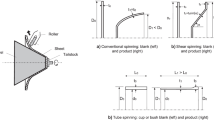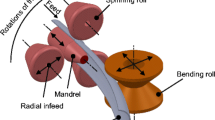Abstract
The primary objective of this study is to predict the geometric shape and thickness change during multi-pass tube spinning to a hemispherical shape. A computationally efficient, axisymmetric finite element model of the tube-spinning experiments is described. Uniaxial tensile tests are conducted for the development of the material model. The post-necking hardening curve is identified using a hybrid experimental-numerical method and represented by a combined Swift-Voce model. For validation of the finite element model, spinning experiments are performed at room temperature on thin-walled cylinders of 6061-O aluminum alloy. The experiments are interrupted after spinning passes 2, 4, 6, and 8 and the shape and thickness are measured. Also, local strain measurements on the final spun tube (pass 8) are accomplished by a scribed grid. By comparing the predictions to the experiments, good agreement is obtained on the shape, thickness, and strain evolution in multi-pass spinning. The deformation mechanism of this process is described by analyzing the history of plastic strain on an element of the numerical model.
















Similar content being viewed by others
Change history
10 October 2020
The original published article contained a mistake.
Abbreviations
- β :
-
material parameter (Voce law)
- ε 0 :
-
material parameter (Swift law)
- ε θ :
-
hoop strain
- \( \overline{\varepsilon_t^p} \) :
-
logarithmic plastic strain
- η :
-
constant
- λ :
-
constant
- μ :
-
friction coefficient
- σ t :
-
true stress
- σ s :
-
true stress (Swift law)
- σ v :
-
true stress (Voce law)
- a :
-
weight ratio of hybrid Swift and Voce law
- k 0 :
-
material parameters (Swift law)
- l 0 :
-
material parameter (Voce law)
- n :
-
material parameter (Swift law)
- q :
-
material parameter (Voce law)
- O :
-
annealing heat treatment condition
- w 0 :
-
initial width of the 1/8th tensile specimen
- w(y):
-
variation of width along axial direction
- y :
-
axial (Cartesian coordinate system)
- z :
-
axial (cylindrical coordinate system)
References
Kalpakjian S, Rajagopal S (1982) Spinning of tubes: a review. J Appl Metalwork 2(3):211–223. https://doi.org/10.1007/BF02834039
Music O, Allwood JM, Kawai K (2010) A review of the mechanics of metal spinning. J Mater Process Technol 210(1):3–23. https://doi.org/10.1016/j.jmatprotec.2009.08.021
Wong CC, Dean TA, Lin J (2003) A review of spinning, shear forming and flow forming processes. Int J Mach Tool Manu 43(14):1419–1435. https://doi.org/10.1016/S0890-6955(03)00172-X
Jiang SY, Zheng YF, Ren ZY, Li CF (2009) Multi-pass spinning of thin-walled tubular part with longitudinal inner ribs. T Nonferr Metal Soc 19(1):215–221. https://doi.org/10.1016/S1003-6326(08)60255-1
Liu CH (2007) The simulation of the multi-pass and die-less spinning process. J Mater Process Technol 192:518–524. https://doi.org/10.1016/j.jmatprotec.2007.04.021
Wang L, Long H (2011) Investigation of material deformation in multi-pass conventional metal spinning. Mater Des 32(5):2891–2899. https://doi.org/10.1016/j.matdes.2010.12.021
Ram Mohan T, Mishra R (1972) Studies on power spinning of tubes. Int J Prod Res 10(4):351–364. https://doi.org/10.1080/00207547208929937
Roy MJ, Klassen RJ, Wood JT (2009) Evolution of plastic strain during a flow forming process. J Mater Process Technol 209(2):1018–1025. https://doi.org/10.1016/j.jmatprotec.2008.03.030
Hayama M, Kudo H (1979) Analysis of diametral growth and working forces in tube spinning. Bulletin of JSME 22(167):776–784. https://doi.org/10.1299/jsme1958.22.776
Chang SC, Huang CA, Yu SY, Chang Y, Han WC, Shieh TS, Chunga HC, Yao HT, Shyua GD, Hou HY, Wang CC, Wang WS (1998) Tube spinnability of AA 2024 and 7075 aluminum alloys. J Mater Process Technol 80:676–682. https://doi.org/10.1016/S0924-0136(98)00174-5
Davidson MJ, Balasubramanian K, Tagore GRN (2008) An experimental study on the quality of flow-formed AA6061 tubes. J Mater Process Technol 203(1-3):321–325. https://doi.org/10.1016/j.jmatprotec.2007.10.021
Srinivasulu M, Komaraiah M, Rao CKP (2012) Experimental studies on the characteristics of AA6082 flow formed tubes. J Mech Eng Res 4(6):192–198. https://doi.org/10.5897/JMER11.063
Yao J, Murata M (2005) An experimental study on spinning of taper shape on tube end. J Mater Process Technol 166(3):405–410. https://doi.org/10.1016/j.jmatprotec.2004.08.025
Yao J, Murata M (2002) Effects of indented feed of roller tool on parallel spinning of circular aluminum tube. J Mater Process Technol 128(1-3):274–279. https://doi.org/10.1016/S0924-0136(02)00465-X
Akkus N, Kawahara M (2006) An experimental and analytical study on dome forming of seamless Al tube by spinning process. J Mater Process Technol 173(2):145–150. https://doi.org/10.1016/j.jmatprotec.2005.11.011
Zoghi H, Arezoodar AF, Sayeaftabi M (2013) Enhanced finite element analysis of material deformation and strain distribution in spinning of 42CrMo steel tubes at elevated temperature. Mater Des 47:234–242. https://doi.org/10.1016/j.matdes.2012.11.049
Huang CC, Hung JC, Hung C, Lin CR (2011) Finite element analysis on neck-spinning process of tube at elevated temperature. Int J Adv Manuf Technol 56(9-12):1039–1048. https://doi.org/10.1007/s00170-011-3247-0
Wong CC, Lin J, Dean TA (2005) Effects of roller path and geometry on the flow forming of solid cylindrical components. J Mater Process Technol 167(2-3):344–353. https://doi.org/10.1016/j.jmatprotec.2005.05.039
Kezhi L, Nanhai H, Yan L, Kemin X (1998) Research on the distribution of the displacement in backward tube spinning. J Mater Process Technol 79(1-3):185–188. https://doi.org/10.1016/S0924-0136(98)00009-0
Hua FA, Yang YS, Zhang YN, Guo MH, Guo DY, Tong WH, Hu ZQ (2005) Three-dimensional finite element analysis of tube spinning. J Mater Process Technol 168(1):68–74. https://doi.org/10.1016/j.jmatprotec.2004.10.014
Parsa MH, Pazooki AMA, Ahmadabadi MN (2009) Flow-forming and flow formability simulation. Int J Adv Manuf Technol 42(5-6):463–473. https://doi.org/10.1007/s00170-008-1624-0
Zhan M, Zhou Q, Yang H, Zhang J (2007) Establishment of 3D FEM model of multi-pass spinning. Chin J Mech Eng 20(4):19–23. https://doi.org/10.3901/CJME.2007.04.019
Alberti N, Cannizzaro L, Valvo EL, Micari F (1989) Analysis of metal spinning processes by the Adina code. Comput Struct 32(3-4):517–525. https://doi.org/10.1016/0045-7949(89)90343-X
Liu JH, Yang H, Li YQ (2002) Study of the stress and strain distributions of first-pass conventional spinning under different roller-traces. J Mater Process Technol 129(1-3):326–329. https://doi.org/10.1016/S0924-0136(02)00682-9
Mori KI, Nonaka T (2005) Simplified three-dimensional finite element simulation of shear spinning process based on axisymmetric modeling. J Manuf Process 7(1):51–56. https://doi.org/10.1016/S1526-6125(05)70081-5
Raujol-Veillé J, Toussaint F, Tabourot L, Vautrot M, Balland P (2015) Experimental and numerical investigation of a short, thin-walled steel tube incremental forming process. J Manuf Process 19:59–66. https://doi.org/10.1016/j.jmapro.2015.03.008
ASTM E8 / E8M-16, 2016, “Standard test methods for tension testing of metallic materials,” ASTM international, West Conshohocken, PA, https://doi.org/10.1520/E0008_E0008M-16, www.astm.org.
Korkolis YP, Kyriakides S (2008) Inflation and burst of anisotropic aluminum tubes for hydroforming applications. Int J Plast 24(3):509–543. https://doi.org/10.1016/j.ijplas.2007.07.010
Knysh P, Korkolis YP (2017) Identification of the post-necking hardening response of rate-and temperature-dependent metals. Int J Solids Struct 115:149–160. https://doi.org/10.1016/j.ijsolstr.2017.03.012
Ha J, Baral M, Korkolis YP (2018) Plastic anisotropy and ductile fracture of bake-hardened AA6013 aluminum sheet. Int J Solids Struct 155:123–139. https://doi.org/10.1016/j.ijsolstr.2018.07.015
Baral M, Ha J, Korkolis YP (2019) Plasticity and ductile fracture modeling of an Al–Si–Mg die-cast alloy. Int J Fract 216(1):101–121. https://doi.org/10.1007/s10704-019-00345-1
Swift H (1952) Plastic instability under plane stress. J Mech Phys Solids 1(1):1–18. https://doi.org/10.1016/0022-5096(52)90002-1
Voce E (1948) The relationship between stress and strain for homogeneous deformation. J Inst Met 74:537–562
Chen WH (1971) Necking of a bar. Int J Solids Struct 7(7):685–717. https://doi.org/10.1016/0020-7683(71)90088-6
Hoge KG (1966) Influence of strain rate on mechanical properties of 6061-T6 aluminum under uniaxial and biaxial states of stress. Exp Mech 6(4):204–211. https://doi.org/10.1007/BF02326150
Manes A, Peroni L, Scapin M, Giglio M (2011) Analysis of strain rate behavior of an Al 6061 T6 alloy. Procedia Eng 10:3477–3482. https://doi.org/10.1016/j.proeng.2011.04.573
Roy, B. K., Korkolis, Y. P., Arai, Y., Araki, W., Iijima, T., & Kouyama, J., 2019, “Experimental and finite element investigation of wrinkling during spinning of a thin-walled tube,” Proceedings of the NUMIFORM Conference, pp. 547–550.Belytschko, T., Liu, W.K., Moran, B. and Elkhodary, K., 2013, “Nonlinear finite elements for continua and structures,” John Wiley & sons.
Zienkiewicz, O.C., and Taylor, R.L., 2000, “The finite element method: solid mechanics,” Vol. 2, Butterworth-Heinemann.
Bathe KJ (2002) Finite element methods. Springer-Verlag, Berlin, Heidelberg
Belytschko, T., Liu, W.K., Moran, B. and Elkhodary, K., 2013, “Nonlinear finite elements for continua and structures,” John Wiley & sons.Roy, B. K., Korkolis, Y. P., Arai, Y., Araki, W., Iijima, T., & Kouyama, J., 2019, “Experimental and finite element investigation of wrinkling during spinning of a thin-walled tube,” Proceedings of the NUMIFORM Conference, pp. 547–550.
Banabic, D., 2010, “Sheet metal forming processes: constitutive modelling and numerical simulation,” Springer Science & Business Media.Hoge KG (1966) Influence of strain rate on mechanical properties of 6061-T6 aluminum under uniaxial and biaxial states of stress. Exp Mech 6(4):204–211. https://doi.org/10.1007/BF02326150
ABAQUS, 2014, “Theory Manual,” Version 6.14, Simulia, Inc.
Funding
This study received financial support from the Ministry of Education, Science, Sports, and Culture, of the Government of Japan.
Author information
Authors and Affiliations
Corresponding author
Additional information
Publisher’s note
Springer Nature remains neutral with regard to jurisdictional claims in published maps and institutional affiliations.
Appendices
Appendix 1
This Appendix tabulates the coordinates of the roller during spinning (see Table 2).
Appendix 2
This Appendix describes the comparison of results from the axisymmetric and a 3D shell element model. Due to the high computational time, only part of the first spinning pass was considered. A monitoring element at 50 mm from the free end (see Fig. 17) was selected in both models. Figure 18 compares the evolution of the hoop and meridional plastic strains during spinning. The models predict similar tendencies for the evolution of the strains, as well as a similar reduction in radius. On the other hand, the computational cost of the two models is vastly different: the corresponding solution times are listed in Table 3: the shell element model took approximately 500 times more to run than the axisymmetric one (i.e., approx. 10 days vs. 30 min). This is the reason why only the beginning of the spinning was simulated for this comparison. Furthermore, attempts to use the explicit solver for this problem were thwarted by numerical instabilities, at least for this high radius-to-thickness ratio of about 71. Therefore, in this work, the implicit axisymmetric model is used.
Appendix 3
The simulation procedure that is executed by the commercial FE package ABAQUS is presented here. For simulation purposes, tube spinning is considered a quasi-static non-linear contact problem. Figure 19 presents the flow chart of the non-linear FE computational solution algorithm (Chapter 2, Section 2.2 in [39]). Figure 20 displays in more detail the flow chart of Coulomb friction algorithm, as used in ABAQUS (Chapter 5, Section 5.2.3 in [39]). Lastly, Fig. 21 shows the schematic that explains the geometric parameters associated with a contact pair involving a master (here, roller) and a slave (here, tube) surface.
Rights and permissions
About this article
Cite this article
Roy, B.K., Korkolis, Y.P., Arai, Y. et al. Experimental and numerical investigation of deformation characteristics during tube spinning. Int J Adv Manuf Technol 110, 1851–1867 (2020). https://doi.org/10.1007/s00170-020-05864-z
Received:
Accepted:
Published:
Issue Date:
DOI: https://doi.org/10.1007/s00170-020-05864-z









